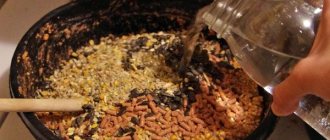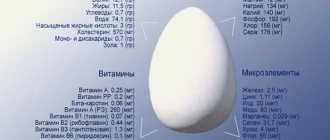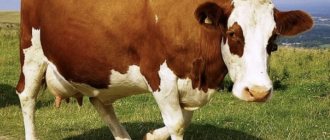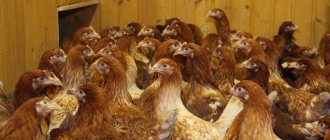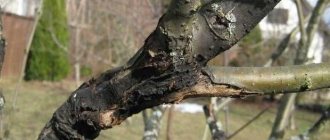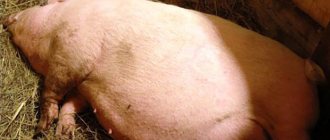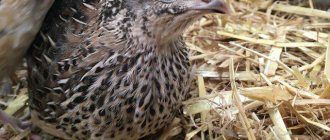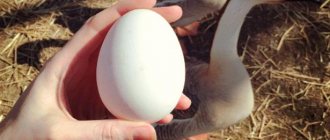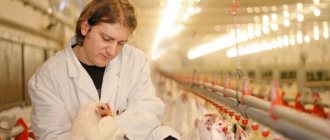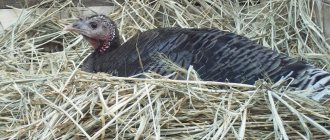Diet for poultry during the molting period
With a protein-poor diet, laying hens lose a lot of feathers on their backs.
The hen's plumage itself becomes dull, loose, and unkempt. The bird takes on a sloppy appearance. You can help laying hens at this time with good care and nutritious food.
Many people ask: how to treat naked chickens? Treatment of birds during natural molting is not required.
For good egg production, the bird's diet must have a high protein content. Therefore, laying hens need to be heavily fed with protein during the molting period.
The basis should be selected animal feed:
- meat and bone meal;
- fishmeal;
- blood meal;
- feather meal;
- skimmed milk, whey.
Don’t think that adding just one of the above feeds will solve the problem in the chicken coop. Only by alternating or feeding all the ingredients in the right proportions will you get the result.
During the molting period, you should not restrict the bird from walking. A large walk or frequent walks in a natural meadow are excellent for laying hens in recovery. The chicken itself will find food of animal origin there:
- worms;
- larvae;
- insects;
- slugs.
Experienced poultry farmers notice that those laying hens that have constant free grazing moult unnoticed and do not reduce egg production.
What to feed laying hens during molting
Laying hens moult quickly or slowly, but in any case, the bird loses a lot of strength and energy at this time. And in order for the new feathers to grow beautifully, it is necessary to provide the laying hens with a sufficient amount of vitamins and minerals. Chickens at this time need:
- vitamins A, B1, B3, D;
- minerals: iodine, calcium, sulfur, manganese;
- amino acids methionine and cysteine;
- protein (5% above normal).
Molting of chickens after the productive period
To provide chickens with these substances, it is necessary to include in the diet:
- fish and dairy waste, yeast, meal;
- fresh grass, nettles, peas;
- boiled and fresh zucchini, cucumbers, any root vegetables, cabbage;
- berries (viburnum, hawthorn);
- mineral supplements (shell rock, chalk, bone meal);
- insects, that is, animal protein (bugs, larvae, worms);
- feed with plenty of protein.
A single portion is always poured into the feeders so that the food does not stagnate, especially for fresh mash. The water is changed at least once a day, but more often is possible.
Other causes of feather loss in chickens
Molting in feathered pets can occur untimely for a number of reasons. The phenomenon is undesirable and leads to weakening of the bird.
Be sure to read:
Marek's disease in chickens: first signs and treatment, is it possible to eat the meat of sick birds
Chickens can start shedding feathers in the following cases:
- lack of vitamins and minerals in the body;
- low nutritional value of the diet;
- severe stress;
- severe helminthic infection;
- abundance of skin parasites;
- intestinal diseases;
- skin pathologies.
It is important to quickly eliminate the influence of the factor causing feather loss. It will not be possible to stop the process completely, but it will be possible to reduce the amount of shedding. It is important to quickly eliminate the influence of the factor causing feather loss
It is important to quickly eliminate the influence of the factor causing feather loss
Eliminating undesirable factors is quite simple by paying attention to them in time:
- An overly active rooster. When adding a male to hens, you should take into account his size and activity. The rooster must be suitable in weight for the laying hens (it is advisable to buy a bird of the same breed). If the rooster is very active, 2-3 more females are required than is generally recommended. If the conditions are not met, the hens will be subject to too much stress, leading to loss of feather cover and decreased egg production.
- Cannibalism. Pecking in chickens causes feather loss. The phenomenon occurs when improper feeding, excessively crowded housing, too bright lighting in the chicken coop, or the placement of aggressive and peace-loving breeds in the same room. The solution depends on the reason for its appearance.
- Wrong neighborhood. Keeping chickens in a poultry house with aggressive turkeys and geese leads to neighbors starting to pluck the laying hens. As a result, the bird constantly loses feathers.
If feather loss occurs in chickens outside of molting, the cause of the phenomenon should be immediately determined. Leaving the problem unattended is unacceptable.
Preparations for artificial shedding
The easiest way to achieve the desired result is by using special tools. Many owners add to their animals' food:
- thyroidin;
- thyroxine;
- progesterone.
Hormones have a positive effect on the body and allow you to cope with changes faster. A number of vitamins are also recommended:
- IN 1;
- A;
- D;
- B3
It is recommended to add manganese and iodine to the water. They also have a positive effect on the restoration of feather cover.
In the case of drugs, you need to be as careful as possible in dosages. The fact is that exceeding the norm will not only not help the chicken, but will also harm it. Subsequently, the recovery process will drag on for weeks or end in death. Therefore, it is better to consult a veterinarian.
Feather loss - pathology
The loss of feathers in a chicken is not always a physiological norm. Sometimes the causes of baldness in birds should be sought in diseases. What could be the reason for untimely loss of a pen?
The reasons for feather loss in laying hens can be different:
- the age of the bird is physiological old age;
- disruptions in feeding and diet;
- violation of conditions of detention;
- parasites (downer eaters, mites)
Poultry farms do not keep chickens for more than 1 year due to economic unprofitability. At home, you can keep some breeds of laying hens for up to 3 years, and seasonal feather loss is normal.
Dirty, dull, loose, unkempt plumage can be caused by the conditions in which the poultry is kept - excessive crowding, high humidity in the chicken coop.
The cause of feather loss can be parasites - feather eaters, mites. Diagnosing the disease is easy - you need to examine the bird.
Mites are difficult to detect on laying hens. The insect moves onto the bird at night, and when morning comes, it moves to the wooden surfaces of the cage and to secluded places. A hungry tick is white (transparent), a well-fed tick is red.
You can suspect a parasite attack if:
- the bird loses a feather;
- worries;
- reduces egg production;
- young animals stop growing.
Chickens have different methods of controlling parasites.
In the presence of down-eaters, it is necessary to use acaricidal preparations (powders, sand and ash baths, aerosols).
In case of a tick attack, the poultry house must be treated. The most accurate diagnosis would be an examination by a specialist veterinarian.
When does shedding start?
The period of intense egg production lasts until August. At this time, the day is quite long, the night is short, the diet is provided with highly nutritious vitamin feed.
Then the day becomes shorter and the night longer, and the bird reacts to this by preparing for the winter period.
Since nature has thought out everything to the smallest detail, feathers do not fall out overnight. This is a gradual process.
A poultry farmer, examining the poultry house, begins to notice a slight increase in fallen feathers.
If the diet is balanced, then the chickens can moult gradually and not lose much productivity. They will not experience intense feather shedding.
If the diet is poor in proteins, then the chickens stop laying eggs. At the same time, it is clearly visible how the feathers on the back fall out. The color of the plumage becomes dull, the feathers are brittle, short, and dirty. Chickens take on a sloppy appearance.
After 3-4 weeks, they begin to acquire feathers, and egg production begins to recover.
Methods for inducing forced molting
There are different ways to do this. The choice is determined by the owner’s experience, as well as his level of knowledge in matters of chicken physiology.
Zootechnical
Artificial “dressing up” of birds is provoked, for example:
- reduction of daylight hours;
- reducing the amount of feed;
- drinking restrictions.
Each of these factors is stressful for birds, and the combination of all three is guaranteed to lead to molting and ensure its occurrence in the shortest possible time. Before the events begin, the birds eat and drink as much as they want, and their daylight hours range from 15 to 18 hours.
In order for molting to begin, different zootechnical schemes are used. Here is one of them:
- 5 days before, 20 g of purified oat grains, as well as a premix with vitamins A and D3, are added to the main menu, the calorie content of which is 2600 kcal/kg of metabolizable energy, and the level of crude protein is 16%. Bi (thiamine) and sulfur.
- further, from the 1st to the 3rd day, water and food are not given at all. The duration of daylight hours is reduced to 8 hours: for a whole month;
- on the 4th day, chickens are given plenty to drink, and for feeding they are given 20 g of pure oats per individual;
- on the 5th - they offer a lot of water, as well as 40 g of oats per chicken;
- on the 6th and subsequent days, give plenty of fluids and a normal diet.
When the month of 8-hour daylight is over, over the next 10 days the daylight hours in the coop are gradually increased to 16 hours.
Hormone
The effectiveness of this method is based on the action of drugs containing hormones such as thyroxine and progesterone, as well as their derivatives. With the introduction of drugs into the body, the production of folliculotropin in laying hens decreases, they begin to molt, and temporarily stop laying eggs.
Table 1. The use of hormones that cause an artificial change in plumage in chickens
| Name | Dose | How to use | Note |
| Progesterone with a component that prolongs its action (injection) | 30-40 mg per 1 hen | 1 time | Reduce daylight hours to 8 hours per month. Feed and water normally |
| Thyroidin (feed additive) | 7 g per 1 hen | 1 time or divide the dose over 2-3 days | With a single dose, old feathers fall off faster |
| Progesterone (injection) | 20 mg per 1 hen | 1 time, and again after 1.5-2 weeks. | Can be used to reduce reproductive functions in chickens 4-5 months old. |
| SAR (progesterone analogue drug) | 13.2 mg per 1 kg of feed | 3-5 weeks | _ |
Chemical
Laying hens are given injections of drugs, and chemicals and compounds are also added to the feed that inhibit the activity of hormones responsible for ovulation.
Under the influence of drugs, chickens experience a change in feathers and temporarily stop producing eggs. After cancellation, productivity is restored.
Preparing for the moult
Preparing a flock for a change of plumage involves providing the birds with sufficient amounts of calcium. This is important because the hardness of the eggshell and the condition of the bird's skeleton depend on it.
Before starting such a procedure, you must make sure that the birds are healthy. All sick representatives are isolated. Blood tests determine the presence of diseases in chickens. Establish proper living conditions for pets in the chicken coop. Antibody titer is checked. The temperature is maintained at 22°C. The duration of daylight should be at least 15 hours, humidity is maintained at 50-60%.
Caring for birds during molting
During this period, birds become too sensitive to weather conditions and temperature changes. Therefore, in the autumn-winter period, it is recommended to keep the bird in a warm chicken coop to prevent hypothermia. The room is well lit for a long time - at least 15 hours a day. Walking in the fresh air is possible, but only under a canopy that protects from precipitation.
You should not touch the chickens too much. Molting can confidently be called a painful and difficult process. During this period, the bird's skin becomes sensitive to pain. The papillae of growing feathers bleed even with minor injuries. The animals themselves try to hide in secluded corners in order to exclude or minimize contact with any objects.
Walking chickens under a canopy
If the cause is infection with a down-eater, then the barn is treated with disinfectant compounds.
| Drug name | Dosage | Processing frequency |
| Entomozan Super (0.1% water emulsion) | 25–50 ml/m2 | at 15–20 °C - 2 times every 10–20 days; from 20 °C - 2 times every 5–8 days |
| Drucker | 5–10 ml per 1 liter of water for non-absorbent surfaces; 10–20 ml per 1 liter of water for rough walls and other absorbent materials | 1 time, effective for at least 3–6 weeks |
If infected with parasites, treat the chicken coop
The bird itself is also subjected to processing. To do this, use special insecticides that are safe for the chickens. The same products are also suitable for disinfecting chicken coop premises.
| Name | Dosage per head | Note |
| Insectoacaricidal powder | 10–15 g | Apply using a dust sprayer |
| Butox (1 ml/4 l water) | 3 liters of solution | Processing at high air temperatures is not recommended |
Some preparations for treating poultry are suitable for disinfecting premises
If the cause of molting is stress, it is necessary to eliminate the factor that caused it.
Artificial shedding: why is it needed and how is it done?
Since the seasonal shedding of feathers lasts several weeks and negatively affects egg production and weight, many owners prefer to speed up this process. This helps to reduce the molting period and resume mass production.
Artificial intervention can be varied:
- using folk remedies;
- with the help of special drugs.
Laying hens are very vulnerable birds, so both the second and first options should be used with extreme caution. It is better to use it in autumn and summer, when molting takes the longest.
Feeding
The main things to pay attention to:
- sufficient amount of feed per head;
- sufficient feeding front (so that some do not take food from others);
- good quality feed - feeding moldy, rotten feed is not allowed;
- protein content at 15-17%;
- the food must be filled with a sufficient amount of energy (carbohydrates, fats).
You can read more about balanced feeding in our article.
Feed distribution should be carried out at least twice a day. The first feeding is done after turning on the light, the second - about 6 hours before bedtime or 8-10 hours after the first.
If there is a lack of protein, the egg production of chickens will drop sharply, and if replenished, it will increase. Sometimes in a poultry house you can observe a false decrease in egg production - “casting” of eggs. This happens when there is a lack of calcium, when a chicken lays an egg without a shell, and it is lost on the litter or eaten by the bird.
A sharp drop in productivity may occur due to lack of water. It is better to give laying hens plenty of water, but you can also resort to dosed watering. In this option, water is given simultaneously with food.
They make sure that there is enough for all the chickens, and also pay attention to the quality of the water - it must meet drinking standards
When do chickens molt?
Many owners are interested in the question: “when do chickens molt?” During the first year of a chicken's life, several similar periods occur:
- Once the little chicks are four weeks old, their first molt occurs. At this time, the first fluff is shed and a new one begins to grow.
- When the young are three months old, they change their plumage again. This time, contour feathers grow, the same as those worn by adult birds.
- Already in the spring, the pullets molt again.
How many days does a turkey sit on eggs?
In the fall, chickens tend to change their feathers every year. Many people are interested in the question: “How many days does it take for chickens to molt and when will they lay eggs?” It should be remembered that in those individuals that are very productive, feathers fall out much more intensely. It is common for them to replace old ones with new ones over a period of six or eight weeks.
Important! Those chickens that look very pitiful and plucked when changing feathers are actually very productive and need to be protected and appreciated.
Laying hens, which lay very poorly throughout the year, molt in the summer, from July to August. Molting continues for several months. This goes unnoticed, since they constantly walk in thick plumage.
Moulting in chickens
If the plumage of chickens changes for a long time, in addition, they become lethargic and slow, this is the first sign that you need to monitor the chicken’s health and take action. The animal is sick or has suffered severe stress. A stressful situation for laying hens can occur:
- as a result of the lack of water, which is why the bird is constantly thirsty;
- chickens are hungry and must get their own food to live;
- In winter, laying hens receive little light.
Important! If laying hens that are two or even three years old begin to lose their feathers, and it is noticed that they are broken, then you need to immediately contact a specialist and look for ways to solve the problem, since this is unnatural for adults.
Chickens tend to change their plumage in the summer when they hatch chicks. When they return to their normal diet, they begin to actively grow new feathers. Other reasons why birds begin to molt may be the following:
- Laying hens do not receive microelements necessary for development with food;
- lack of vitamins in the body;
- attack by parasites that bite through the plumage;
- the occurrence of parasitic worms;
- diseases affecting the skin and intestines.
Once the causes of untimely shedding are identified, they can be addressed quickly and in a timely manner. The stressful situation must be eliminated immediately. To do this, you need to ensure that the birds always have sufficient water and food. In winter, you need to extend daylight hours with the help of artificial lighting. Lighting for chickens is recommended for at least fifteen hours. If you eliminate all these reasons, they will stop shedding.
Seasonal periods
Birds can moult during periods of changing climatic conditions. There are four types of shedding, depending on the season:
- In the spring, chickens can shed feathers they don't need. This process begins in the month of March or April.
- In the summer, chickens lose feathers when a malfunction occurs in the body and it stops functioning properly. The poultry owner should know that summer molting is the first sign of bird disease. This period falls in July and lasts no more than a month.
- In autumn, this is the most necessary process in the chicken’s body. It begins at the end of August or beginning of September and lasts for fifty-five days. In winter, chickens will already have thick and lush plumage.
- In winter, this is the most unnatural process, since the cold period of the year should not provoke feather loss. If this happens, then you should pay attention to the condition of the birds and their health.
How to care for chickens during the molting period?
Feathers consist mainly of protein, and in the process of growing a new coat, the bird’s body is noticeably depleted; during molting, the bird weakens and loses weight. In addition, when the length of daylight hours decreases, chickens experience hormonal fluctuations. As a result of these factors, during feather renewal, productivity drops sharply
To support the bird during molting, it is important to provide it with adequate nutrition.
It is necessary to increase the protein content in the diet of laying hens. This can be done by introducing protein complementary foods of animal or plant origin - fish, worms, insects, soy, and so on. Chickens can also be released to free range, in which case they will be able to enrich their diet with worms, insects and their larvae on their own.
Conventional feed containing 16% protein must be replaced with feed for broilers, in which the amount of protein can reach up to 22%. Additional protein should be no more than 5% of the bird's standard daily ration.
Of particular importance are feeds that contain a lot of sulfur:
- peas;
- cabbage;
- meat and bone meal;
- dairy products;
- alfalfa;
- clover.
You can also add sulfur to any food - 1 g per 1 kg will be enough.
Additionally, you can support chickens by introducing vitamin supplements into their diet.
During the molting period, it is better not to pick up a chicken; this will cause pain to it and can also cause bleeding in the sheaths of growing feathers. You should avoid any tactile contact with the bird.
Also, if possible, you should avoid any stress. Proper care will help laying hens and improve their egg production.
Just during the molting of adult chickens, when they do not produce eggs, the young begin to lay eggs. Birds that are in the process of renewing their plumage need to be combined into one flock with these pullets. If possible, it is necessary to ensure that the share of the latter is one third.
Food for moulting birds
During molting, the body of birds is greatly weakened and consumes a lot of energy. Therefore, it is recommended to create the right diet to ensure a continuous supply of vitamins and other useful components.
Experts recommend saturating chickens’ bodies with manganese and iodine. These microelements are found in beets, berries and grass. Chickens also need to be fed insects and earthworms daily. It is contraindicated to feed raw potatoes, as they impair digestion. It is better to use boiled vegetables instead.
Causes
Feathers change in different ways. Depends on the keeping of the bird, its age, breed and time of year. Sometimes the process is almost imperceptible in appearance, sometimes the hens remain almost bald. Young healthy chickens experience this period much more painlessly and faster than adults, for more than 1 year.
Unnatural, localized baldness can be due to several reasons. In most cases, novice poultry farmers face this problem.
Poor nutrition
If feeding rules are not followed, chickens may not receive the required amount of vitamins and microelements. In addition to the loss of feathers, they have dullness of the combs, lack of shine on the plumage, and a decrease in egg production.
Recommended recovery methods:
- diversify and increase the amount of feed;
- add special mineral supplements to your diet;
- give sulfur or Glauber's salt along with food at the rate of 1 g per 1 individual;
- Give potassium permanganate and potassium iodide with food and water after 2-3 days.
A hungry bird begins to go bald in the same way, so the amount of food should be calculated. For 1 adult individual, up to 150 g of mixed feed is prescribed; in winter, the norm is increased. Laying hens need a balanced diet at any time of the year. Therefore, rational owners prepare all the necessary ingredients for future use.
Incorrect conditions of detention
Molting of laying hens often occurs due to their living in unsuitable conditions; it is not difficult to correct the situation.
- Clean the room and treat it with disinfectants.
- Provide outdoor walks in any weather.
- Maintain recommended air temperature.
- Equip a ventilation system in the room.
It is necessary to take care of the availability of dry, high-quality bedding, cleanliness of feeders and drinkers. Birds should not be kept in a damp room without ventilation. There should always be enough light. The litter is changed regularly to prevent rotting.
Advice! Keeping large numbers of chickens in close quarters is contraindicated. Neighborhood with another bird during the molting period is undesirable.
If possible, laying hens should be separated from the rest of the flock to avoid stressful situations.
Nutrition rules: when and how much?
An equally important aspect is the dosage. Even the most balanced food may not be enough or too much. Therefore, before feeding the bird, you should make sure that everything is in moderation.
The basic rule is that you need to use the usual dose of food that was given before molting as a basis. You can speed up the process by increasing:
- protein in the diet up to 22%;
- calcium no more than 1%.
Laying hens in cage conditions are fed more abundantly, since they do not have the opportunity to obtain food on their own. Experts recommend increasing vitamin supplements by 15%.
Feeding is carried out three times a day or in another order familiar to chickens. If the diet includes wet food, the feeders should be cleaned and washed before each meal. The water should be changed daily with the addition of 2-4 drops of iodine or manganese per 1 liter.
What kind of molting can it be?
The type and time of molting in chickens differ in functionality and degree of impact on the body. How laying hens of different ages will behave depends on the breed, living and care conditions, as well as the time of the process:
- Juvenile or primary. This type of molting occurs in chickens during active growth and development. The juvenile (primary) feather changes to the primary (secondary) feather. The time of molting depends on the breed of chickens. Chicks of egg breeds molt the earliest - starting at four weeks of age, then meat and universal breeds begin to shed their old feathers - at 5-6 weeks until the start of egg laying.
- Seasonal. Such molting is inherent in nature, as a result of the bird’s body’s standard reaction to cold weather and shortening daylight hours. Chickens shed their feathers gradually or quickly (the process is influenced by age and breed) in order to acquire thicker and denser feathers that will help them survive the cold season with short daylight hours.
- Natural. As soon as the bird’s productive period ends, it is time for the body to adapt to changing weather conditions. This type of molting occurs at 13-14 months and lasts three to four months with a sharp decrease in body weight. Chickens first shed the feathers on their necks, then their back and the rest of their body become exposed. This is where experienced farmers begin culling low-productive birds that shed old feathers for a long time and evenly. In contrast, good laying hens molt quickly and in parts, which looks quite pitiful and untidy, the appearance becomes “plucked”, but this is a sure sign of the most valuable hens and excellent laying hens with high egg production. Unlike chickens, roosters begin to molt as early as 10-11 months and faster, and the weight loss is not as critical as that of laying hens.
- Forced. Using special techniques (hormonal, chemical and zootechnical), artificial molting is induced in birds in the summer, usually in July or August, which is characterized by a short period of time - from 45 to 60 days and the simultaneous replacement of feathers in the entire chicken population. After the end of such a moult, in birds under favorable housing conditions, a second, better-quality egg-laying cycle quickly begins. Forced molting of chickens of any age should only be carried out by experienced poultry farmers after consultation with a veterinarian, provided good feed and care are available and only on healthy birds. Any incorrect actions can seriously impair the health of laying hens and cause irreversible consequences.
- Painful. This type of molting occurs when chickens become ill or experience severe stress, or as a result of poor quality nutrition. In this case, it is advisable to check the conditions of detention, the condition of the food, and also, if necessary, consult with a veterinarian about further actions.
As you can see, molting in spring, summer and autumn is acceptable, but undesirable in winter, which is why farmers use different methods to speed up the process before the onset of cold weather.
The beneficial effect of natural methods of molting in chickens causes an increase in the productivity of laying hens and an improvement in presentation and quality. The more actively molting occurs in healthy hens in favorable conditions, the sooner they will begin to lay eggs.
What is shedding?
Molting is a physiological process characterized by the death of old feathers and down and their replacement with new ones.
It leads to physiological changes in the chicken’s body, which requires special care during this period.
The feathers on the neck and head fall out first, then on the back and chest. The hips and tail are the last to be replaced. The appearance of a molting bird becomes unattractive due to its thinning plumage.
Molting is a physiological process
A hen changing feathers stops laying eggs due to excessive stress on the body.
Causes of chicken molting
Shedding in chickens can be divided into three areas:
- Seasonal.
- Juvenile (age).
- Stressful.
Based on the names, you can easily determine the causes of each type of molting. So, in the first case, feather loss occurs naturally when the chicken needs to renew its plumage. Seasonal molting in chickens occurs in all birds without exception, but it can occur differently in each of them.
Juvenile molting occurs in chickens of all breeds. At this time, the young temporary feather is replaced by a permanent one. Egg breeds typically begin shedding at four weeks of age, while meat breeds do not begin moulting until six weeks after hatching. The period of juvenile molting ends with the beginning of egg laying. Often the tail feathers fall out first, then the first and second row of flight feathers, and finally all the other feathers on the chick's body fall out.
During this period, cockerels molt more intensively than hens. Often, chickens of meat and meat-egg breeds are selected during juvenile molting based on the intensity of feather loss. There is no need to do anything during this period.
Loading …
Another reason for emergency molting may be stress (loud noise, reduced daylight hours, changes in feeding). Sometimes farmers use stress specifically to reduce the time of natural molting. In some cases, chickens are given hormones and other compounds containing chemicals. But this method does not always lead to a positive result. The process of seasonal molting is inherent in nature and should occur naturally.
When does shedding start?
It is generally accepted that chickens molt with the onset of cold weather, when daylight hours begin to noticeably decrease. There is an opinion among farmers that the later the molting begins and the worse the chicken looks at this moment, the better a laying hen it will turn out to be. This fact has been proven more than once, and therefore experienced poultry farmers during this period select the best laying hens from among the hens, and use the rest for meat.
Some hens begin molting in July or even earlier. During the feather replacement, the bird does not lose its attractiveness and does not even stop laying eggs. Sometimes it’s even difficult to understand from the outside whether this chicken is currently molting. But it’s too early to rejoice, because a good laying hen sheds intensely and during the period of losing the old feather and growing a new one, it can have a completely unsightly appearance, and this is quite normal.
Why do chickens lay fewer eggs? This is explained by the fact that the bird spends more energy and protein on molting at this time. In the spring (or even earlier) the situation will change for the better.
How long does it take to replace feathers?
Ideally, molting in hens begins in the period from October to December and lasts from four to eight weeks. In the spring, the egg-laying function of the hen should be fully restored, and the feathers on her body should take on a beautiful, healthy and shiny appearance. If this does not happen, then you need to look for the reason in feeding or stress experienced.
During seasonal molting, the feathers on the neck fall out first, then on the back, tail, and finally on the wings. This is not a mandatory rule, but rather a familiar standard. When good laying hens begin to molt, they immediately lose weight and look completely unattractive. What do we have to do? Just feed the bird well and leave the rest to nature.
How to find out the stage of shedding
The poultry farmer must know the stages of the moulting process in order to know when the process is over and egg laying begins. One way is to count the fallen flight feathers.
On the wing of a chicken there are feathers of the first and second order (10 pieces each). In the center of the row there is a dividing feather, which is half as long as the others. The feather replacement process begins from the middle of the row. One dropped feather counts as 10%. By counting the number of feathers shed, you can determine the stage of molting. The old plumage differs from the new one in dryness, presence of dirt and broken ends. When counting, it is enough to examine 10% of the birds to make a decision about the stage of the process.
Features of molting chickens
Changing feathers is a normal process for chickens and is repeated every year. Over 12 months, the feathers wear out and become weaker. Rapid molting in domestic chickens requires large energy expenditures, therefore, during the molting period, egg production in chickens decreases or disappears altogether. After the end of the period, the birds lay eggs once every 4 days, gradually increasing productivity. If the hen starts producing eggs once every 1-2 days, her body has fully recovered.
Laying hens moult in stages. Egg breeds shed first, then meat-egg and meat breeds. The feathers on the most mobile parts of the body - the head, neck, legs - fall off first. Afterwards the back, belly and chest shed. At the end, the feathers of the wings and tail change. This sequence allows the birds to retain some heat and gradually expend energy on growing new feathers.
Natural shedding
Chickens molt at a certain time, it does not depend on the breed. Most often, a change in plumage occurs in young individuals. Adult chickens need more time to change feathers. Roosters moult faster and earlier than females.
There are several periods of natural molting in chickens:
- one-month-old chicks exchange down for down plumage;
- at the age of 3 months, chickens begin to sprout contour feathers, which will not fall out until the end of their lives;
- spring molting in chickens in the first year of life occurs at the age of 9-12 months;
- at a more mature age, chickens begin molting in the fall and occur every year at approximately the same time.
The process lasts from 6 to 8 weeks. At this time, chickens lose weight, become weaker, and require good care. Some hens molt more slowly, extending the process to 14 weeks or longer. At the same time, the loss of strength has little effect on their appearance.
Spring molting of chickens is considered normal if individuals shed excess winter feathers. In summer (July or August) there are periods when birds slowly change their plumage; this lasts 20-28 days. In autumn, the molting of chickens is characterized by the formation of a denser winter feather layer. When chickens shed particularly heavily and for a long time in the winter, this indicates an illness caused by parasites or problems with food and husbandry. Particularly dangerous are cases when molting in chickens begins in the summer and does not end by winter.
Forced shedding
It is used on large poultry farms when there is a need to increase egg production and speed up the process of growing new plumage. Before starting the process, the health of the birds and the conditions of the chicken coop are assessed, weak flocks are excluded, and the premises are disinfected.
When forced molting of chickens, they are guided by natural periods of plumage change, so it is carried out in the fall or spring. There are two main approaches used:
- When special preparations are introduced into the food, the change in plumage is accelerated, and the production of reproductive hormones slows down. For this purpose, hormonal agents are used - “Thyroidin”, “Thyroxine”, “Progesterone”, or chemical ones - containing iodine, calcium, nilevar, protamon. The appearance of these drugs in the laying hen’s body causes a stressful state. After excluding them from the diet, the feather cover begins to quickly change, the bird returns to normal and resumes egg production.
- Traditional medicine recipes and animal science techniques also give positive results at home. Daylight hours are reduced to 15 hours. The amount of food and drink is reduced to a minimum for 4-10 days, with an emphasis on fiber. Such actions also lead to stress, and therefore cause accelerated plumage loss.
It has been discovered more than once that after forced molting, chickens began to produce eggs of greater mass and size. The amount of product also increases significantly, especially during periods of active walking in the fresh air in the warm season. The first egg after molting appears even before the formation of new feather cover is completed.
Forced molting is carried out to increase egg production
Shedding due to illness
Untimely or prolonged molting in chickens can be caused by parasitic organisms on the skin and feathers (helminths), skin diseases and disorders of the gastrointestinal tract. The reasons may be insufficient amounts of vitamins and minerals, constant and severe stress. Uncomfortable conditions, a cold chicken coop, and dirt can also disrupt the process.
In such cases, the entire livestock looks sick, eats poorly, and rarely walks in the fresh air. They are trying to fix the problem by expanding the space of the chicken coop. In cases where the formation of new plumage takes a long time and is painful, you should consult a veterinarian.
After molting
Healthy chickens recover quickly after molting, but require special attention. In addition to improved nutrition, they are provided with comfortable conditions, depending on the time of year and conditions of detention. In winter, when the feathers are partially absent, it is worth adjusting the temperature in the chicken coop. Install additional heat sources so that the air warms up by at least 20 degrees.
Laying hens reach maximum egg production at approximately 5-6 months of age. After a year of life, by the time of seasonal molting, the percentage of egg production decreases by almost 2 times. After 1.5-2 months, having recovered, the chickens will begin to lay eggs again. But one cannot expect the same efficiency from them. They will begin to lay eggs after molting much worse, no more than 80% of the previous results.
Chickens do not grow feathers after molting in case of alopecia, a disease that causes baldness. A bird loses feathers, regardless of the season, living conditions and age. There are several causes of the disease:
- Poor nutrition. A lack of vitamins and microelements or their excess has a negative effect. Inexperienced owners cannot calculate the required amount of feed and mineral supplements. Or they prepare a diet from incompatible ingredients.
- Inappropriate conditions of detention. The reason for the loss of plumage may be: high humidity in the chicken coop, low temperatures, lack of sunlight, unsanitary conditions.
Chickens often develop parasites. Among the most common:
- chicken mites;
- lice eaters and feather eaters;
- fleas.
First, the plumage loses color and shine, after which the bird gradually becomes bald. Traces of bruising and signs of damage are visible on the skin. When the first signs of the disease appear, you should immediately seek help from a veterinarian. Start treatment with drugs:
- "Chiktonik";
- "Gamavit";
- "Ganasuprevit";
- "Desi spray";
- "Operin."
Operin
Effective use of antiparasitic agents: “Frontline”, “Neomostozan”, “Ivomek”. Chicken coops and cages are treated with special preparations. Popular folk remedies and methods:
- The fallen feathers are ground into flour and added to feed. Cysteine contained in plumage promotes the formation of new ones.
- Useful microelements are obtained from the ground horns and hooves of any artiodactyl animal.
As a preventive measure, boxes with ash are installed in the premises. Regularly take measures to exterminate rodents.
Complete care will help restore plumage in the shortest possible time.
Healthy chickens recover quickly after molting, but require special attention. In addition to improved nutrition, they are provided with comfortable conditions, depending on the time of year and conditions of detention.
In winter, when the feathers are partially absent, it is worth adjusting the temperature in the chicken coop. Install additional heat sources so that the air warms up by at least 20 degrees.
After a year of life, by the time of seasonal molting, the percentage of egg production decreases by almost 2 times. After 1.5-2 months, having recovered, the chickens will begin to lay eggs again. But one cannot expect the same efficiency from them.
They will begin to lay eggs after molting much worse, no more than 80% of the previous results.
There is also a risk that “false” laying hens will appear among the livestock. They are easily recognized by their enlarged cockscomb.
Chickens do not grow feathers after molting in case of alopecia, a disease that causes baldness. A bird loses feathers, regardless of the season, living conditions and age.
First, the plumage loses color and shine, after which the bird gradually becomes bald. Traces of bruising and signs of damage are visible on the skin.
When the first signs of the disease appear, you should immediately seek help from a veterinarian.
Tags: when About the author: admin4ik
How to speed up molting in laying hens
If chickens begin to molt, the feathers on their neck and back fall out, but the process is delayed, then they need help. For this purpose, forced molting is carried out. This is a new thing for a novice poultry farmer, but experienced ones hold such an event every year.
What to do if chickens have worms - a useful article about this. Also, any poultry farmer may encounter the appearance of lice and fleas in chickens; read how to deal with this here.
Poultry farms previously practiced coercion, but the latest trends boil down to the fact that as soon as a bird produces its main egg, it is discarded and completely replaced with young animals. However, especially valuable specimens are susceptible to molting.
At home, you need to think in advance about what to do and how to organize the event.
It is important to decide on the temperature. If it is very hot during the day, the procedure is delayed until the end of September.
Next proceed as follows:
- The bird is locked in the chicken coop in the evening;
- Windows, vents, and any openings are curtained so that light does not penetrate;
- Feed and water are removed from the chicken coop;
- The poultry house is closed for 3-4 days.
As time passes, early in the morning they open the chickens and observe an interesting picture - the floor is covered with feathers. Then the bird will continue to lose feathers for some time, and then become bald. For beginners, the picture is strange and the question arises, how does molting proceed? The mechanism is simple - the bird reacts to stress this way.
Food after molting
After opening the coop, the birds are immediately provided with clean water. At this point, you can acidify it a little - for 1 liter of water - 3-4 g of crystalline citric acid. The approach to drinking bowls should be free and constant, and there should be a sufficient number of drinking bowls themselves.
From grains you can feed:
- corn;
- wheat;
- buckwheat waste.
The animal feed listed above must be present in the diet.
The necessary components are succulent food:
- leguminous herbs;
- grated beets;
- pumpkin;
- cabbage leaf
Expert advice
Viktor Nikolaevich Travnikov
For about 20 years he has been breeding laying hens, broilers, geese, ducks and other poultry. Our expert who is always happy to help readers.
Ask a Question
Chickens need table salt. What to give to add salt - porridge. An excellent option is pearl barley or barley. Initially, it should be soaked for 1-2 hours, and then brought to a boil and salted at the rate of 1-2 g per head. Chickens eat porridge with pleasure. In the diet it should not exceed a fifth of grains.
Useful video about molting layer course
Like the author!34
- Even more interesting:
- How and what to feed laying hens to lay eggs better
- What to do if chickens stop laying eggs
- What to feed broiler chickens for rapid growth
Discussion: 4 comments
- Tolik:
10/29/2018 at 11:03Now I know at what age laying hens molt, thank you.
Answer
- Victoria:
12/17/2018 at 20:50
I just started raising chickens and this aspect of changing feathers is new to me. I want to thank you for the tips in this article on how to help chickens change their feathers. I plan to put them into practice and hope that all my chickens will quickly change their feathers with my help.
Answer
- Igor:
01/30/2019 at 20:15
Thank you for suggesting how to care for chickens so that there is a quick change of feathers. Now I will do everything right!
Answer
- Anna:
08/26/2020 at 05:37
I have been breeding laying hens for a long time. But despite this, I learned a lot of useful things from your article. Thank you
Answer
